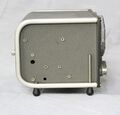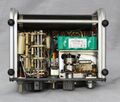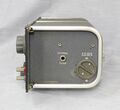1232-A: Difference between revisions
Jump to navigation
Jump to search
No edit summary |
No edit summary |
||
| Line 15: | Line 15: | ||
The '''General Radio 1232-A Tuned Amplifier and Null Detector''' was introduced in {{Catalog Q}} and remained available through {{Catalog 1978}}. | The '''General Radio 1232-A Tuned Amplifier and Null Detector''' was introduced in {{Catalog Q}} and remained available through {{Catalog 1978}}. | ||
The | The 1232-A is a solid-state, battery-operated tuned amplifier and null detector. Its tuned frequency range covers 20 to 20 kHz in 5 bands, plus a flat response setting. | ||
As a null detector, the 1232-A is part of the GR [[1660-A]] Inductance and [[1620-A]] Capacitance Measurement Systems. Battery operation is provided by nine M72 cells (now obsolete). | |||
The instrument shown in the photos below has been converted to a rechargeable battery pack. | |||
(Instructions for this conversion are covered in a document below.) | |||
==Specifications== | ==Specifications== | ||
* '''Frequency Response:''' | * '''Frequency Response:''' | ||
* Tunable Filters: 20 Hz to 20 kHz in 3 ranges; 5% bandwidth; 2nd harmonic at least 34 dB down from peak, 3rd at least 40 dB down | * Tunable Filters: 20 Hz to 20 kHz in 3 ranges; 5% bandwidth; 2nd harmonic at least 34 dB down from peak, 3rd at least 40 dB down | ||
* 50 kHz and 100 kHz Filters: 2nd harmonic 44 and 53 dB down, respectively | * 50 kHz and 100 kHz Filters: 2nd harmonic 44 and 53 dB down, respectively | ||
* Flat Response: | * Flat Response: ±3 dB from 20 Hz to 100 kHz | ||
* '''Input Impedance:''' Approximately 50 kΩ at maximum gain, varies inversely with gain to 1 MΩ at minimum gain | * '''Input Impedance:''' Approximately 50 kΩ at maximum gain, varies inversely with gain to 1 MΩ at minimum gain | ||
* '''Gain:''' 120 dB on the tunable ranges; 100 dB, flat range; 106 dB at 50 kHz; 100 dB at l00 kHz position | * '''Gain:''' 120 dB on the tunable ranges; 100 dB, flat range; 106 dB at 50 kHz; 100 dB at l00 kHz position | ||
==Links== | ==Links== | ||
Revision as of 01:56, 3 April 2024
The General Radio 1232-A Tuned Amplifier and Null Detector was introduced in Catalog Q (1961) and remained available through Catalog 1978.
The 1232-A is a solid-state, battery-operated tuned amplifier and null detector. Its tuned frequency range covers 20 to 20 kHz in 5 bands, plus a flat response setting.
As a null detector, the 1232-A is part of the GR 1660-A Inductance and 1620-A Capacitance Measurement Systems. Battery operation is provided by nine M72 cells (now obsolete). The instrument shown in the photos below has been converted to a rechargeable battery pack. (Instructions for this conversion are covered in a document below.)
Specifications
- Frequency Response:
- Tunable Filters: 20 Hz to 20 kHz in 3 ranges; 5% bandwidth; 2nd harmonic at least 34 dB down from peak, 3rd at least 40 dB down
- 50 kHz and 100 kHz Filters: 2nd harmonic 44 and 53 dB down, respectively
- Flat Response: ±3 dB from 20 Hz to 100 kHz
- Input Impedance: Approximately 50 kΩ at maximum gain, varies inversely with gain to 1 MΩ at minimum gain
- Gain: 120 dB on the tunable ranges; 100 dB, flat range; 106 dB at 50 kHz; 100 dB at l00 kHz position
Links
- Experimenter describing Type 1232-A July 1961
- Experimenter describing 1232-P2 Preamplifier February 1967
- GR 1232-A Battery Conversion







